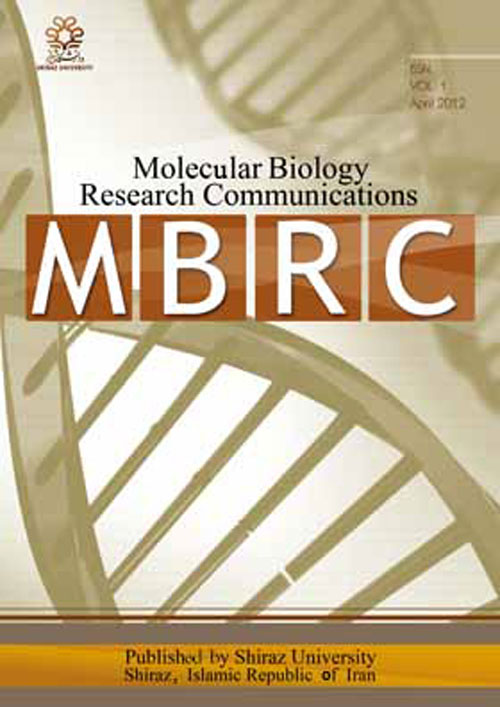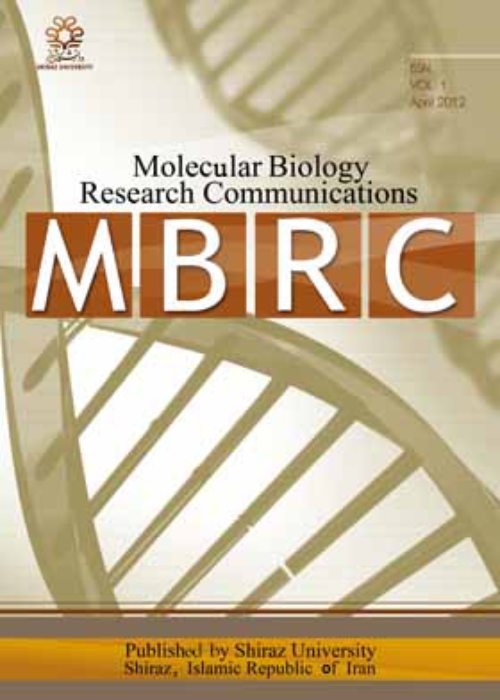فهرست مطالب

Molecular Biology Research Communications
Volume:4 Issue: 2, Jun 2015
- تاریخ انتشار: 1394/03/28
- تعداد عناوین: 6
-
-
Pages 63-66Angiotensin converting enzyme (ACE; OMIM: 106180) has an important role in the conversion of angiotensin I to angiotensin II and degradation of bradykinin. Genetic polymorphism I/D (rs4646994) in the gene encoding ACE has been well defined. To get more insight into the genetic structure of Iranian populations, the distribution of the ACE I/D polymorphism among Iranians was compared with each other and with other populations. Prevalence of the D allele was 0.5886 (95% CI: 0.5725-0.6047) in Iran. There was significant difference between Iranian populations (Chi2=27.7, df=6, P2=10.15, df=5, P=0.071). The D allele showed high frequency in Iran which is similar to Caucasians.Keywords: ACE, Iran, Polymorphism, Population genetics
-
Pages 67-72Linkage studies and epidemiological findings indicate that some possible genes in schizophrenia (SCZ) and bipolar mood disorder (BPD) are common. Numerous evidences for linkage of two diseases on chromosome 22 have been found. These findings suggest that one or more genes in the 22q11.21 region may be involved in the development of both disorders. In the present case-control study, association between the mentioned disorders and a genetic polymorphism (rs165599) of catechol O-methyltransferase (COMT, OMIM: 116790) was studied. Here 100 BPD patients, 100 SCZ patients, and 100 healthy controls were included in the study. The samples were matched in terms of gender and ethnicity. Statistical analysis showed that there was a significant association this polymorphism and risk of SCZ. The AG (OR=7.41, 95% CI: 3.21-17.1, PKeywords: Bipolar mood disorder, COMT gene, rs165599, Schizophrenia
-
Pages 73-82In the recent years deregulation for microRNAs expression pattern have emerged as a possible molecular factor for carcinogenesis. It has been reported that the expression of miR-9 was down-regulated in human gastric adenocarcinoma. To figure out the molecular mechanism of this down regulation, the methylation status in promoters of miR-9 family loci were compared in the human gastric adenocarcinoma samples with their normal margins. Using a methylation specific PCR technique the methylation status of miR-9 family loci were compared between 30 pairs of primary human gastric adenocarcinoma samples with their normal margins. The methylation of miR 9-1 status showed no specific difference in promoter methylation pattern in tumor and normal specimens, while in the miR-9-2 locus were unmethylated in both types of tissues. The promoter of miR-9-3 locus seems to be specifically methylated in tumor and their normal margin tissues. Our data revealed methylation of these CpG islands were not meaningfully different between normal and tumor gastric adenocarcinoma specimens and the methylation status of promoter may not be able to account for alteration of miR-9 expression in this type of gastric cancer.Keywords: Gastric cancer, Epigenetic, DNA methylation, miR, 9, MS, PCR
-
Pages 83-91Myxosporean taxonomy which is traditionally based on the morphology of the myxospore stage, is in a state of flux given new insights provided by the expanding dataset of DNA sequences. To date, more than 40 species of Thelohanellus from India have been described according to morphometric characteristics. Nevertheless, molecular data on these histozoic myxosporean parasites of freshwater fish are scarce. In the present study, molecular characterizations of Thelohanellus qadrii infecting the secondary gill epithelium of Indian major carp Catla catla (Hamilton, 1822) and its phylogenetic relationship is reported. The sub-adult cultured catla were observed to have low to moderate gill myxosporean infections. The morphometry of mature spores was in compliance with original descriptions of T. qadrii. Based on the analysis of 18S rRNA gene, phylogenetic clusters which were established according to a consensus sequence, illustrated the taxonomic placement of a series of myxobolids. The DNA sequence homogeneity of T. qadrii (KF170928) with other Thelohanllus spp. ranged from 78% to 95% and formed a dichotomy with cyprinid gill lamellae infecting T. toyamai (HQ338729). Distance matrix results indicated a high genetic diversity among myxosporeans. The present report is the first on the molecular and phylogenetic characterizations of T. qadrii.Keywords: Catla catla, Myxosporean infection, Thelohanellus qadrii, Molecular characterization, Phylogenetic relationship
-
Pages 93-103Understanding cattle metabolism and its relationship with milk products is important in bovine breeding. A systemic view could lead to consequences that will result in a better understanding of existing concepts. Topological indices and quantitative characterizations mostly result from the application of graph theory on biological data. In the present work, the enzyme network involved in cattle milk production was reconstructed and analyzed based on available bovine genome information using several public datasets (NCBI, Uniprot, KEGG, and Brenda). The reconstructed network consisted of 3605 reactions named by KEGG compound numbers and 646 enzymes that catalyzed the corresponding reactions. The characteristics of the directed and undirected network were analyzed using Graph Theory. The mean path length was calculated to be 4.39 and 5.41 for directed and undirected networks, respectively. The top 11 hub enzymes whose abnormality could harm bovine health and reduce milk production were determined. Therefore, the aim of constructing the enzyme centric network was twofold; first to find out whether such network followed the same properties of other biological networks, and second, to find the key enzymes. The results of the present study can improve our understanding of milk production in cattle. Also, analysis of the enzyme network can help improve the modeling and simulation of biological systems and help design desired phenotypes to increase milk production quality or quantity.Keywords: Cattle, Milk Production, Enzyme Network, Graph Theory, Metabolism
-
Pages 105-114Very little is known about LHR and FSHR genes of domestic dromedary camels. The main objective of this study was to determine and analyze partial genomic regions of FSHR and LHR genes in dromedary camels for the first time. To this end, a total of 50 DNA samples belonging to dromedary camels raised in Iran were sent for sequencing (25 samples of each gene). We compared the nucleotide sequences of Camelus dromedarius with corresponding sequences of previously published FSHR and LHR genes in bactrian camels and other species. According to the data, the same nucleotide variation was identified in both regions of the two camel species. The alignment of deduced protein sequences of the two different species revealed an amino acid variation at the FSHR region. No evidence of amino acid variation was observed, however, in LHR sequences. Phylogenetic analysis indicated that both camel species had a close relationship and clustered together in a separate branch. This was further confirmed by genetic distance values illustrating significant sequence identity between Camelus dromedarius and Camelus bactrianus. Interestingly, sequence comparisons revealed heterozygote patterns in FSHR sequences isolated from dromedary camels of Iran. In comparison to other species, this camel contains three amino acid substitutions at 5, 67, and 105 positions in the FSHR coding region. These positions are found exclusively in camels and can be considered as species specific. The results of our study can be used for hormone functionality research (FSHR and LHR) as well as reproduction-linked polymorphisms and breeding programs.Keywords: FSHR, LHR, Sequence, Camel


